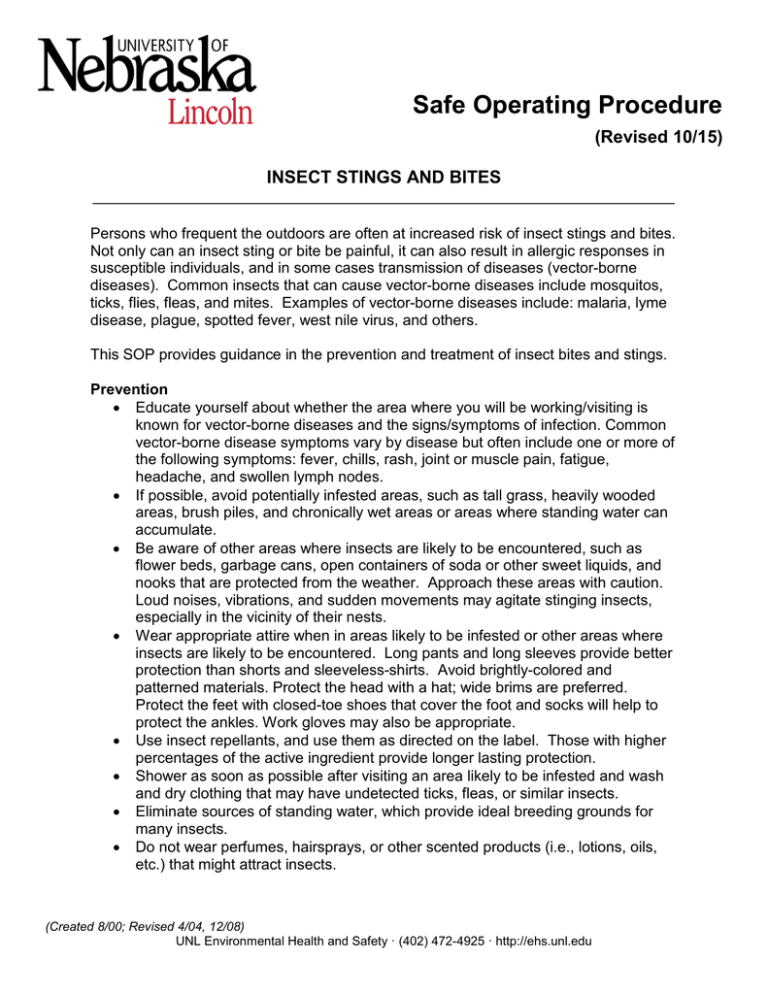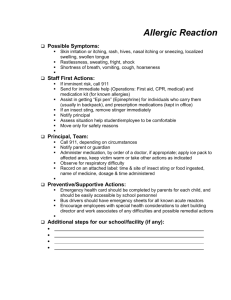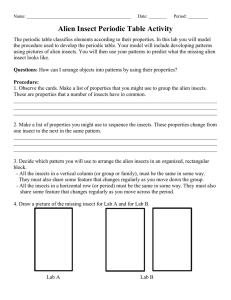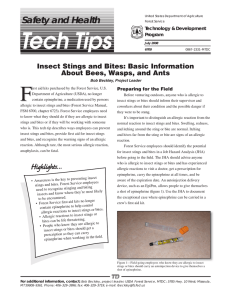Safe Operating Procedure (Revised 10/15) INSECT STINGS AND BITES
advertisement

Safe Operating Procedure (Revised 10/15) INSECT STINGS AND BITES _____________________________________________________________________ Persons who frequent the outdoors are often at increased risk of insect stings and bites. Not only can an insect sting or bite be painful, it can also result in allergic responses in susceptible individuals, and in some cases transmission of diseases (vector-borne diseases). Common insects that can cause vector-borne diseases include mosquitos, ticks, flies, fleas, and mites. Examples of vector-borne diseases include: malaria, lyme disease, plague, spotted fever, west nile virus, and others. This SOP provides guidance in the prevention and treatment of insect bites and stings. Prevention • Educate yourself about whether the area where you will be working/visiting is known for vector-borne diseases and the signs/symptoms of infection. Common vector-borne disease symptoms vary by disease but often include one or more of the following symptoms: fever, chills, rash, joint or muscle pain, fatigue, headache, and swollen lymph nodes. • If possible, avoid potentially infested areas, such as tall grass, heavily wooded areas, brush piles, and chronically wet areas or areas where standing water can accumulate. • Be aware of other areas where insects are likely to be encountered, such as flower beds, garbage cans, open containers of soda or other sweet liquids, and nooks that are protected from the weather. Approach these areas with caution. Loud noises, vibrations, and sudden movements may agitate stinging insects, especially in the vicinity of their nests. • Wear appropriate attire when in areas likely to be infested or other areas where insects are likely to be encountered. Long pants and long sleeves provide better protection than shorts and sleeveless-shirts. Avoid brightly-colored and patterned materials. Protect the head with a hat; wide brims are preferred. Protect the feet with closed-toe shoes that cover the foot and socks will help to protect the ankles. Work gloves may also be appropriate. • Use insect repellants, and use them as directed on the label. Those with higher percentages of the active ingredient provide longer lasting protection. • Shower as soon as possible after visiting an area likely to be infested and wash and dry clothing that may have undetected ticks, fleas, or similar insects. • Eliminate sources of standing water, which provide ideal breeding grounds for many insects. • Do not wear perfumes, hairsprays, or other scented products (i.e., lotions, oils, etc.) that might attract insects. (Created 8/00; Revised 4/04, 12/08) UNL Environmental Health and Safety · (402) 472-4925 · http://ehs.unl.edu • • • Remain calm if a stinging insect comes near. Do not swat at or flail arms around bees. This will only cause them to become more aggressive. Avoid those hours that the insect of interest is most active. For example, mosquitos are most active at dusk and dawn. Bees and wasps are most active at the warmest parts of the day. If the working area is suspected to be frequented by bees or wasps, conduct this work in the early morning or at night when the weather is cooler and the insects are slower and less active. Maintain ready access to communication equipment such as cellular phone or two-way radio to summon help in the event of an emergency. With rare exception, most adults will suffer a mild localized reaction to an insect sting. This reaction generally consists of pain, redness, localized swelling, and itching at the site of the sting. There is no need for alarm with this type of reaction – it is normal. Wash the sting site with soap and water. Application of cold pacts may provide comfort, and over the counter antihistamines can ease mild allergic reactions. However, persons with severe allergies to insect venom or persons who have been stung multiple times may suffer systemic reactions that require medical attention. Persons known to have severe allergies should consult their physician to determine if they should carry a personal supply of epi-pens. Persons experiencing severe allergy symptoms should seek medical attention. Severe symptoms may include hives and itching on the body at locations away from the bee sting site; swelling of the throat; chest tightness; swelling of the lips or other areas of the body; difficulty breathing; heart palpitation; nausea; vomiting; and fainting. Seek medical attention if experiencing signs/symptoms of a vector-borne disease and having been in a location where such a disease could have been contracted. (Created 8/00; Revised 4/04, 12/08) UNL Environmental Health and Safety · (402) 472-4925 · http://ehs.unl.edu







